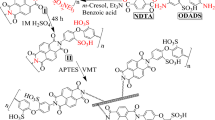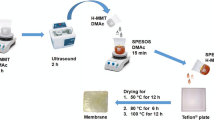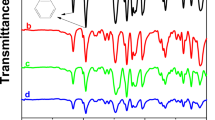Abstract
Sulfonated polyimide (SPI) using 1, 4, 5, 8-Naphthalenetetracaboxylic Dianhydride was fabricated by a one-step high-temperature direct imidization method in the presence of organo-modified clay (sepiolite) as reinforcement in the polymer matrix. Different sets of SPI and clay sepiolite (in different content 1–7 wt. %) in the form of thin films were fabricated by the solution casting method. These films were cast at a temperature of 80 °C for 12 h followed by curing at 150 °C and 180 °C for 1 and 6 h, respectively. Several physicochemical parameters and analytical techniques were performed to characterize the newly fabricated nanocomposite membranes. Ion exchange capacity and hydrolytic study results showed the impact of clay content on the hydrolytic stability and morphology of hybrid membranes. Lowering in ion exchange capacity with higher hydrolytic stability was observed by increasing the clay contents in the polymeric matrix. The as-synthesized membranes were tested for its oxidative stability by Fenton reagent and observed that membrane with 5-wt (%) clay presented the maximum oxidative stability. The SPI-clay hybrid membrane with 7 wt.% of clay exhibited a water-uptake of 3.03% at 40 °C and proton conductivity of 2.45 mmol/g at 25 °C, while the pure SPI showed the values of 3.62% and 3.12 mmol/g in the same experimental conditions. FT-IR analysis investigated the structural aspects of neat SPI and all other synthesized nanocomposite membranes. The thermogravimetric analysis examined the presence of inorganic materials in the synthesized membranes along with their thermal stability profile. X-ray diffraction patterns were used to scrutinize the crystalline nature of neat sulfonated polyimide and the SPI-Clay composites membrane. In conclusion, these nanocomposite membranes can be applied as proton exchange films in fuel cells for energy application due to their interesting physicochemical, morphological, structural, and electrochemical properties.








Similar content being viewed by others
References
Kraytsbery A, Ein-Eli Y (2014) Review of advanced material for proton exchange membrane fuel cells. Energy Fuels 28:7303–7330
Oh K, Ketpang K, Kim H, Shanmugam S (2016) Synthesis of sulfonated poly(arylene ether ketone) block copolymers for proton exchange membrane. J Membr Sci 507:135–142
Jiao K, Ni M (2017) Challenges and opportunities in moddelling of proton exchange membrane fuel cells (PEMFC). Int J Energy Res 41(13):1793–1797
Haoran X, Bin C, Peng T, Houcheng Z, Jinliang Y, Jiang L, Meng N (2017) Performance improvement of a direct carbon solid oxide fuel cell system by combining with a stirling cycle. Energy 140:979–987
Shaari, N Kamarudin, SK (2019) Recent advances in addditive enhanced polymer electrolyte membrane properties in fuel cell application: an overview. Int J Energy Res. 1, 39.
Ketpang, K Oh, K L Lim, S C Shanmugam, S (2016) Nafion-porous cerium oxide nanotubes composite membrane for polymer electrolyte fuel cells operated under dry conditions. J Power Sources. 329, 441–449.
Ketpang, K Shanmugam, S Suwanboon, C Chanunpanich, N Lee, DH (2015) Efficient water management of composite membranes operated in polymer electrolyte meembrane fuel cells under low relative humidity. J Membr Sci.493, 285–298.
Sahu, AK Ketpang, K Shanmugam, S Kwon, O Lee, SC Kim, HS (2016) Sulfonated graphene-Nafion composite membranes for polymer electrolyte fuel cells operating under reduced relative humidity . J Phys Chem C. 120, 15855–15866.
Jang, S Y and Han, S H (2015) Sulfonated polySEPS/hydrophilic-SiO2 composite membranes for polymer electrolyte membranes (PEMs). J Ind Eng Chem. 23, 285–289.
Liu B, Robertson G, Kim D, Guiver M, Hu W, Jiang Z (2007) Aromatic poly(ether ketone)s with pendant sulfonic acid phenyl groups prepared by a mild sulfonation method for proton exchange membranes. Macromolecules 40:1934–1944
Lin, CH Chang, SL Cheng, PW (2011) Soluble High-Tg Polyetherimides with Good Flame Retardancy Based on an Asymmetric Phosphinated Etherdiamine. J Polym Sci Part A: Polym. Chem. 49, 1331−1340.
Lin CH, Chang SL, Cheng PW (2011) Dietheramine from an alkaline-stable phosphinated bisphenol for soluble polyetherimides. Polymer 52:1249–1255
Bisoi S, Mandal AK, Singh A, Padmanabhanb V, Banerjee S (2017) Soluble, optically transparent polyamides with a phosphaphenanthrene skeleton: synthesis, characterization, gas permeation and molecular dynamics simulations. Polym Chem 8:4220–4232
Adjemian, KT Srinivasan, SJ Benziger, J Bocarsly, AB (2002) Investigation of PEMFC operation above 100 °C employing perfluorosulfonic acid silicon oxide composite membranes. J Power Sources 109(2), 356–364. https://doi.org/10.1016/S0378-7753(2)00086-1
Simari C, Potsi G, Policicchio A, Perrotta I, Nicotera I (2016) Design and development of novel layered nanostructured hybrid materials for environmental, medical, energy and catalytic applications. J Phys Chem C 120:2574–2584
Jiang, R Kunz, HR Fenton, JM (2006) Composite silica/Nafion® membranes prepared by tetraethylorthosilicate sol–gel reaction and solution casting for direct methanol fuel cells. J Membr Sci.272, 116–124.
Huanga, X Yin, Z Wu, S Qi, X He, Q Zhang, Q Yan, Q Boey, F Zhang, H (2011) Graphene-based materials: Synthesis, characterization, properties and applications. Smal-Journa.com 7, 1876–902.
Ferrari, AC Bonaccorso, F Falko, V Novoselov, K, S Roche, S Boggild, P Borini, S Kopppens, FH Palermo, V Pungno, N (2015) Science and Technology roadmap for Graphene related two dimensional crystals and hybrid systems. Nanoscale 7, 4598–810.
Gaoquan S (2013) Graphene/Polymer composites for energy applications. J Polym Sci B Polym Phys 51:231–253
Zhang J, Tang Y, Song C, Zhang J (2007) Polybenzimidazole-membrane-based PEM fuel cell in the temperature range of 120–200°C. J Pow Sour 172(1):163–171
Ng F, Péron J, Jones DJ, Rozière J (2011) Synthesis of novel protonconducting highly sulfonated polybenzimidazoles for PEMFC and the effect of the type of bisphenyl bridge on polymer and membrane properties. J Polym Sci Part A Polym Chem. 249(10), 2107–17.
Gaowen Z, Zhentao Z (2005) Organic/inorganic composite membranes for application in DMFC,". J Membr Sci 261(1–2):107–113
Bijay T, Vinod S (2011) Organic–inorganic nanocomposite polymer electrolyte membranes for fuel cell applications. Prog Polym Sci 36(7):945–979
Arun, KM Soumendu, B Susanta, B (2019) Effect of phosphaphenanthrene skeleton in sulfonated polyimides for proton exchange membran Application. Appl Polym Mater. 1 893–905.
Farman, A Shaukat, S Syed, S, S Fazal, R Laurent, D Jean, M L Laurence, R (2014) Sulfonated polyimide-clay thin films for energy application. Bentham Science Publishers.10 221–230.
Baolong W, Lihua H, Yunfeng L, Liang Z, Chengji Z, Hui N (2017) Property enhancement effects of side-chain type napthalene-based sulfonated poly(arylene ether ketone) on Nafion compositer membranes for direct methanol fuel cells. Appl Mater Interfaces 9:32227–32236
Geng L, He Y, Liu D, Dai X, Lü C (2012) Facile in situ template synthesis of sulfonated polyimide/mesoporous silica hybrid proton exchange membrane for direct methanol fuel cells. Micro Meso Mate 148(1):8–14
Farman, A Reinert, L Lévêque, J M Duclaux, L Muller, F Saeed, S Shah, SS (2014) Effect of Sonication conditions: Solvent, Time, Temperature and rector type on the preparation micron sized Vermiculite Particles. Ultrasonics sonochemistry. 21(3), 1002–1009.
Kangcheng C, Zhaoxia H, Nobutaka E, Mitsuru H, Ken-ichi O (2011) Sulfonated multiblock copolynaphthalimides for polymer electrolyte fuel cell application. Polymer 52(10):2255–2262
Wonbong J, Saimani S, Seunghyuk C, Yong-Gun S, Haksoo H (2006) Acid–base polyimide blends for the application as electrolyte membranes for fuel cells. J Membr Sci 280(1–2):321–329
Boroglu, M S Cavus, S Boz, I Ata, A (2011) Synthesis and characterization of poly(vinyl alcohol) proton exchange membranes modified with 4,4-diaminodiphenylether-2,2-disulfonic acid. Exp Polym Lett 5 470–78.
Chen K, Hu Z, Endo N, Higa M, Okamoto K (2011) Sulfonated multiblock copolynaphthalimides for polymer electrolyte fuel cell application. Polymer 52(10):2255–2262
Alphonse H, Providence BI, Yuxin Z, Yao L, Na L, Zhaoxia H, Shouwen C (2019) Four polymer blend proton exchange membranes derived from sulfonated poly(aryl ether sulfone)s with various sulfonation degree for application in fuel cells. Journal of Mermbrane Science 583 209–219.
Kundu PP, Taek KB, Eun AJ, Hak SH, Yong GS (2007) Formation and evaluation of semi-IPN of nafion 117 membrane for direct methanol fuel cell: 1. Crosslinked sulfonated polystyrene in the pores of nafion 117. Journal of Power Sources 171(1):86–91.
Bum PH, Hyun L, Chang YS, Joon ML, Young BF, Jun, KH (2006) Effect of crosslinked chain length in sulfonated polyimide membranes on water sorption, proton conduction, and methanol permeation properties. Journal of Membrane Science 285,(1–2):432–443.
Yao, CS Sheng, FC Chin, WT Jing, DC Chunli, G Sheng, W (2008) Sulfonated poly(ether imide) and poly(ether sulfone) blends for direct methanol fuel cells. II. Membrane preparation and performance. Journal of Applied Polymer Science 108(3), 1783–1791.
Acknowledgment
Dr. Farman Ali is highly obliged to the Higher Education Commission (HEC) of Pakistan for supporting this work through the NRPU project (number No: 5723/KPK/NRPU/R&D/HEC/2016).
Author information
Authors and Affiliations
Corresponding authors
Ethics declarations
Conflict of interest
The authors declare that they have no conflict of interest.
Additional information
Publisher’s Note
Springer Nature remains neutral with regard to jurisdictional claims in published maps and institutional affiliations.
Rights and permissions
About this article
Cite this article
Sheikh, Z.A., Ali, N., Ali, F. et al. Fabrication, morphological, structural and electrochemical characterization of sulfonated polyimide/clay-based hybrid nanocomposite membranes for energy application. J Polym Res 28, 72 (2021). https://doi.org/10.1007/s10965-020-02306-y
Received:
Accepted:
Published:
DOI: https://doi.org/10.1007/s10965-020-02306-y




